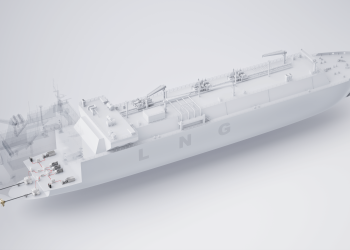ABB Turbo Systems’s space-saving re-design opens way for tw-stroke engines
![]() ABB Turbo Systems says it has played a key role in bringing the benefits of Wärtsilä’s RT-flex technology to two-stroke engine installation onboard smaller ships through a repsotioning of its turbocharger..
ABB Turbo Systems says it has played a key role in bringing the benefits of Wärtsilä’s RT-flex technology to two-stroke engine installation onboard smaller ships through a repsotioning of its turbocharger..
ABB says that owners of smaller merchant vessels increasingly prefer two-stroke, low speed engines over their four-stroke counterparts, in light of fuel savings, lower operating costs and lower emissions. To meet this need, Wärtsilä has reconfigured the layout of the widely specified RT-flex50 version-D engine to overcome width limitations that preclude installation of an engine with an exhaust-side turbocharger attached.
The new layout sees the A170-L unit from ABB Turbo Systems positioned directly above the fly wheel at the driving end of the engine. Wärtsilä licensee Hyundai Heavy Industries, South Korea, recently completed the first shop tests on an RT-flex50 version-D engine to feature an A170-L turbocharger unit from ABB in the new lay-out.
The space-saving step opens the way for the fuel-saving engine type to be offered for ship designs with slim stern sections, including smaller tankers, bulk carriers and ‘handysize’ container vessels.
The HHI tests verified that the configuration provides a viable alternative to other engine types featuring a smaller cylinder bore and higher speed. The first engine to pass the test will be installed on a newbuld at HHI’s Ulsan yard for an undisclosed owner.
According to Alexander Mutter, ABB Turbo Systems Ltd. Manager Sales Engineering Marine: “The D version engine is one of Wärtsilä’s latest generation ‘high efficiency’ RT-flex models, and is designed for optimised performance over the full load range.”
He added: ‘High efficiency’ here means consuming 1g/kWh less fuel over the whole engine load range when compared to the previous standard engine version, in line with fulfilling the International Maritime Organization’s TIER II NOx requirements. For derated engines and special tunings, efficiency gains are even greater. Depending on the engine load, efficiency gains of up to 4.5 g/kWh are possible according to the Wärtsilä layout data for this engine. Lower fuel consumption always reduces CO2 emissions.”
Mr Mutter said that, as well as confirming the configuration’s fuel saving and NOx emissions reducing attributes, the shop tests confirmed that the D engine working with the A170 unit achieved smokeless operation, especially at low loads. He added that the new lay-out conferred more space to service on the turbocharger.
Source: World Bunkering



























































